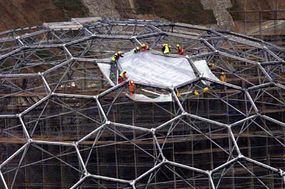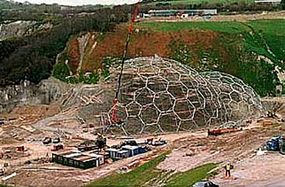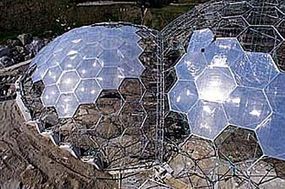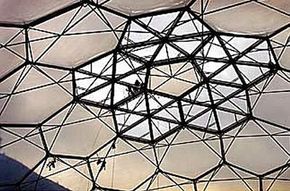The Domes
In the last section, we looked at the most basic greenhouse, a simple box made of transparent glass or plastic. Eden's designers decided not to use these traditional materials in their greenhouses -- they went with glazed ethyl tetra fluoro ethylene (ETFE) foil instead. ETFE foil is a perfect covering for a greenhouse because it is strong, transparent and lightweight. A piece of ETFE weighs less than 1 percent of a piece of glass with the same volume. It is also a better insulator than glass, and it is much more resistant to the weathering effects of sunlight.
The Eden Project designers formed this ETFE material into extremely sturdy pillows, each made from three sheets of ETFE foil welded together along the sides, one on top of the other, with layers of air pumped in between them. The air layers provide increased insulation without decreasing the amount of sunlight that shines through. The coolest thing about these pillows is that they are adjustable: On a colder day, they can be pumped up with more air to provide better insulation; on a hotter day, they can be partially deflated to allow more cooling.
Advertisement
Eden's designers attached pillows together to form geodesic domes. In this sort of structure, many flat panels, formed into triangles, pentagons, hexagons or other polygons, are pieced together to form a curved surface. This design is remarkable because none of the individual pieces are curved at all, but they come together to form a rounded structure.

In the Eden Project domes, these geometric panels are the ETFE pillows. Each pillow is attached to a web of interlocking steel tubes. Each dome actually has two web layers, one with hexagonal and pentagonal panels and one with triangular panels. The total Eden structure uses 625 hexagons, 16 pentagons and 190 triangles.
Like the steel grid in a skyscraper, the steel frame of the geodesic dome is incredibly strong relative to its weight. This weight (667 tons) is dispersed evenly throughout the entire structure so that the dome only needs support around its base, leaving lots of room for the plants inside. The edges of the dome rest on a sturdy foundation necklace, an underground concrete wall around the perimeter of the structure.

Designing these sorts of domes is a mind-boggling exercise in geometry. You have to figure out exactly which shapes to use and how to fit them all together to form a perfectly curved structure. Eden's designers figured everything out using sophisticated computer software. The software generated precise 3-D computer models of the different domes, which the designers fed into an automated production-line computer. Using the 3-D models, this computer determined which pieces the construction crew would need and directed machines to cut steel beams to those exact specifications. When it came time to build the domes, the crew simply followed the instructions and put all of the pieces together.
One advantage of the geodesic dome shape is that it adapts easily to most ground surfaces. Eden's designers describe the domes as giant bubbles that can be set down just about anywhere. The designers built the domes along the side of the pit that faces south, since the Sun is in the southern part of the sky in Cornwall (click here to find out why). The slanted ground is perfectly positioned to absorb thermal energy all day long, heating the air even after the sun has gone down.

Capturing light is only one part of maintaining a greenhouse, of course. For the plants to thrive, you also need to provide good soil and adequate water. In the next section, we'll see how this is done in the Eden Project biomes.
